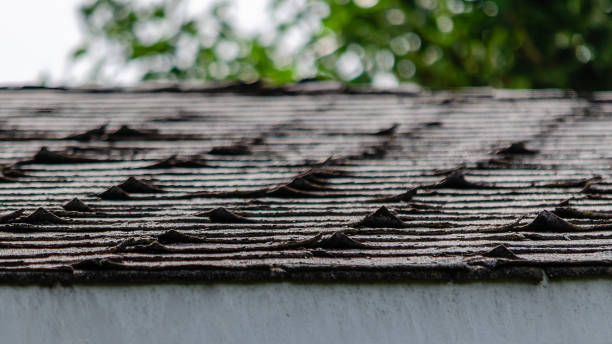10 Signs Your Allentown Home Needs a Roof Replacement (Before Winter)
- sam86878
- Sep 5
- 4 min read
Allentown’s housing stock spans pre-war rowhomes, mid-century ranches, and newer developments across the West End, Old Allentown, South Side, and nearby communities like Whitehall, Emmaus, and Macungie. Many of these roofs are at or past their service life. If you’re seeing any of the signs below, a proactive fall replacement can prevent winter leaks, ice-dam damage, and emergency calls when contractors are booked solid.
1) Curling, cupping, or cracked shingles
Shingles that curl at the edges, cup in the middle, or show widespread cracking have lost flexibility and UV protection. Once the asphalt dries out, wind uplift and water intrusion become likely—especially after Lehigh Valley wind/rain events.

2) Heavy granules in gutters and downspouts
Those “black sand” particles are shingle granules. A handful is normal after a storm; consistent or heavy deposits indicate accelerated wear. Losing granules exposes the asphalt base, speeding up aging and making leaks more likely.
3) Missing or lifted shingles after routine storms
If shingles go missing after ordinary rain/wind (not just severe weather), the roof’s wind-resistance has degraded. Repeated spot repairs can add up—often costing more than a planned replacement.

4) Persistent ceiling stains or attic leaks
Water stains that reappear after each rain—especially around penetrations like bath vents or skylights—signal failing underlayment or aged flashing. If you’re placing buckets during every thunderstorm, it’s time to evaluate the whole system.
5) Soft, spongy, or sagging roof decking
Walking the roof (safely, or during a professional inspection), soft spots suggest compromised sheathing from long-term moisture. A sagging line along the ridge or between rafters also indicates structural concerns that a replacement should address.
6) Moss, algae, or lichen that keeps returning
Green growth traps moisture against shingles and often appears on north-facing slopes shaded by trees—common across Allentown’s mature neighborhoods. Light growth can be treated, but recurring, thick mats usually coincide with advanced shingle wear and poor ventilation.

7) Failing or outdated flashing (chimneys, skylights, walls)
Brick chimneys are everywhere in the Lehigh Valley; deteriorated counter-flashing or dried sealant at the chimney saddle is a classic leak source. If flashing is corroded, patched repeatedly, or installed over multiple shingle layers, replacement is usually smarter than another band-aid.
8) Attic red flags: daylight, wet insulation, or stale, hot air
See daylight through the roof boards? That’s an obvious breach. Equally telling: damp insulation, musty smells, or a stifling attic even in cool weather—signs of ventilation issues that shorten shingle life and drive ice dams in winter.
9) Advanced age (20–25+ years for asphalt)
Architectural asphalt shingles often last 20–25 years in our climate; 3-tab shingles typically less. If your roof is in that age range (or older), even “minor” symptoms can tip the scales toward replacement versus piecemeal repairs.
10) Energy bills creeping up
A tired roof system often pairs with poor ventilation and heat loss. If heating costs climb despite no changes inside, the roof/attic assembly may be underperforming. A new roof with balanced ridge/soffit ventilation can stabilize interior temperatures and reduce ice-dam risk.
Repair or Replace? A quick decision guide
Spot repair may suffice if: damage is isolated (≤10–15% of one slope), the roof is relatively young, and the deck/flashing are sound.
Replacement is likely best if: the roof is 18–25+ years old, leaks are recurring in multiple areas, you see structural or ventilation issues, or repairs are becoming frequent.
Multiple layers present? Many municipalities allow up to two layers of shingles, but full tear-off is typically the better long-term investment: it exposes hidden damage, resets flashing correctly, and lets you install modern underlayments and ventilation.
What Allentown homeowners should do next
Document issues Take photos of ceiling stains, missing shingles, and any granules in gutters. This helps with insurance conversations if storm damage is involved.
Schedule a professional inspection A reputable local roofer will check shingles, flashing, decking, and attic ventilation. Fall books up fast—get on the calendar now to beat the first freeze.
Discuss materials and ventilation Architectural asphalt shingles (we typically install GAF and Owens Corning) are the region’s go-to for value and durability. Pair them with balanced ridge/soffit ventilation and an ice-&-water barrier along eaves and valleys.
Confirm permits and HOA requirements Requirements vary by municipality/association. Your contractor should pull the right permits and align with any HOA color/style rules.
Plan around weather Fall’s moderate temps help shingles seal properly. Aim to complete work before consistent freeze-thaw cycles start—this reduces risk of ice dams and cold-weather delays.

FAQs
How long does a roof replacement take? For an average Allentown single-family home, 1–2 days is common. Complex roofs (multiple dormers, steep pitches) can take longer.
Do I need to be home? Not required. Ensure driveway/yard access is clear, pets are secured, and fragile items in attic spaces are covered.
Can you roof over my existing shingles? Sometimes permitted, but a tear-off is strongly recommended. It lets us replace bad decking, reset flashing, and install modern underlayments for a longer-lasting roof.
Will a new roof help with ice dams? Yes—balanced ventilation plus proper underlayment at eaves/valleys significantly lowers ice-dam risk. Insulation improvements can help, too.
The bottom line
If you’re seeing several of these signs—especially on a roof 20+ years old—don’t wait for a January leak. A planned fall replacement protects your home, reduces emergency calls, and positions your roof to handle winter.
Serving Allentown, Whitehall, Emmaus, Macungie, and the greater Lehigh Valley.👉 Call 910-728-0212 or schedule your inspection online to get a clear, written plan and pricing.
P.S. As part of responsible roof care, we also offer gutter cleaning and soft/pressure washing to keep your exterior and drainage in top shape—simple maintenance that prevents costly roof and siding issues later.



